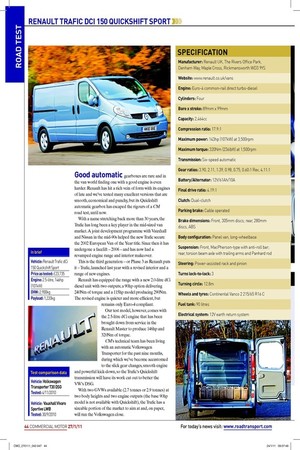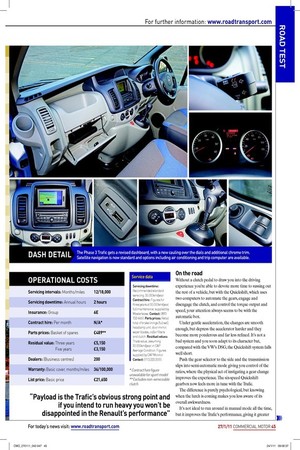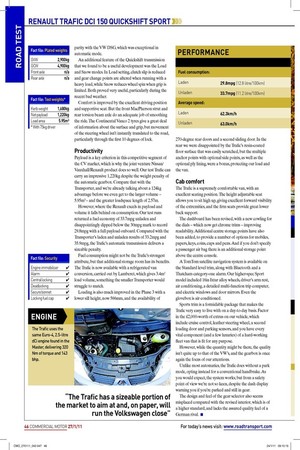Renault
Page 37

Page 39

Page 40

Page 41

If you've noticed an error in this article please click here to report it so we can fix it.
Trafic
dCi 150
Quickshift
or
Does the revamped Renault Trafic’s Quickshift gearbox add anything to the driving experience? CM puts it through its paces to find out
Good automatic gearboxes are rare and in the van world inding one with a good engine is even harder. Renault has hit a rich vein of form with its engines of late and we’ve tested many excellent versions that are smooth, economical and punchy, but its Quickshift automatic gearbox has escaped the rigours of a CM road test, until now.
With a name stretching back more than 30 years, the Traic has long been a key player in the mid-sized van market. A joint development programme with Vauxhall and Nissan in the mid-90s helped the new Traic secure the 2002 European Van of the Year title. Since then it has undergone a facelift – 2006 – and has now had a revamped engine range and interior makeover.
This is the third generation – or Phase 3 as Renault puts it – Traic, launched last year with a revised interior and a range of new engines.
Renault has equipped the range with a new 2.0-litre dCi diesel unit with two outputs; a 90hp option delivering 240Nm of torque and a 115hp model producing 290Nm. The revised engine is quieter and more eficient, but remains only Euro-4 compliant.
Our test model, however, comes with the 2.5-litre dCi engine that has been brought down from service in the Renault Master to produce 146hp and 320Nm of torque.
CM’s technical team has been living with an automatic Volkswagen Transporter for the past nine months, during which we’ve become accustomed to the slick gear changes, smooth engine and powerful kick-down, so the Traic’s Quickshift transmission will have its work cut out to better the VW’s DSG.
With two GVWs available (2.7 tonnes or 2.9 tonnes) at two body heights and two engine outputs (the base 90hp model is not available with Quickshift), the Traic has a sizeable portion of the market to aim at and, on paper, will run the Volkswagen close.
On the road
Without a clutch pedal to draw you into the driving experience you’re able to devote more time to sussing out the rest of a vehicle, but with the Quickshift, which uses two computers to automate the gears, engage and disengage the clutch, and control the torque output and speed, your attention always seems to be with the automatic box.
Under gentle acceleration, the changes are smooth enough, but depress the accelerator harder and they become more ponderous and far less reined. It’s not a bad system and you soon adapt to its character but, compared with the VW’s DSG, the Quickshift system falls well short.
Push the gear selector to the side and the transmission slips into semi-automatic mode giving you control of the ratios, where the physical act of instigating a gear change improves the experience. The six-speed Quickshift gearbox now feels more in tune with the Traic.
The difference is purely psychological, but knowing when the lurch is coming makes you less aware of its overall awkwardness.
It’s not ideal to run around in manual mode all the time, but it improves the Traic’s performance, giving it greater parity with the VW DSG, which was exceptional in automatic mode.
An additional feature of the Quickshift transmission that we found to be a useful development was the Load and Snow modes. In Load setting, clutch slip is reduced and gear change points are altered when running with a heavy load, while Snow reduces wheel spin when grip is limited. Both proved very useful, particularly during the recent bad weather.
Comfort is improved by the excellent driving position and supportive seat. But the front MacPherson strut and rear torsion beam axle do an adequate job of smoothing the ride. The Continental Vanco 2 tyres give a great deal of information about the surface and grip, but movement of the steering wheel isn’t instantly translated to the road, particularly through the irst 10 degrees of lock.
Productivity
Payload is a key criterion in this competitive segment of the CV market, which is why the joint venture Nissan/ Vauxhall/Renault product does so well. Our test Traic can carry an impressive 1,220kg despite the weight penalty of the automatic gearbox. Compare that with the Transporter, and we’re already talking about a 124kg advantage before we even get to the larger volume – 5.95m3 – and the greater loadspace length of 2.57m.
However, where the Renault excels in payload and volume it falls behind on consumption. Our test runs returned a fuel economy of 33.7mpg unladen and disappointingly dipped below the 30mpg mark to record 29.8mpg with a full payload onboard. Compared with the Transporter’s laden and unladen results of 33.2mpg and 35.9mpg, the Traic’s automatic transmission delivers a sizeable penalty.
Fuel consumption might not be the Traic’s strongest attribute, but that additional storage room has its beneits. The Traic is now available with a refrigerated van conversion, carried out by Lamberet, which gives 3.4m3 load volume, something the smaller Transporter would struggle to match.
Loading is also much improved in the Phase 3 with a lower sill height, now 566mm, and the availability of 270-degree rear doors and a second sliding door. In the rear we were disappointed by the Traic’s resin-coated loor surface that was easily scratched, but the multiple anchor points with optional side points, as well as the optional ply lining, were a bonus, protecting our load and the van.
Cab comfort
The Traic is a supremely comfortable van, with an excellent seating position. The height adjustable seat allows you to sit high up, giving excellent forward visibility of the extremities, and the irm seats provide great lower back support.
The dashboard has been revised, with a new cowling for the dials – which now get chrome trims – improving readability. Additional centre storage points have also been added, to provide a number of options for mobiles, papers, keys, coins, cups and pens. And if you don’t specify a passenger air bag there is an additional storage point above the centre console.
A TomTom satellite navigation system is available on the Standard level trim, along with Bluetooth and a Thatcham category-one alarm. Our higher-spec Sport model included 16in Ixtar alloy wheels, driver’s arm rest, air conditioning, a detailed multi-function trip computer, and electric windows and door mirrors. Even the glovebox is air conditioned.
Sports trim is a formidable package that makes the Traic very easy to live with on a day-to-day basis. Factor in the £2,000-worth of extras on our vehicle, which include cruise control, leather steering wheel, a second loading door and parking sensors, and you have every vital component (and a few luxuries) of a hard-working leet van that is it for any purpose.
However, while the quantity might be there, the quality isn’t quite up to that of the VW’s, and the gearbox is once again the focus of our attentions.
Unlike most automatics, the Traic does without a park mode, opting instead for a conventional handbrake. As you would expect, the system works; but from a safety point of view we’re not so keen, despite the dash display warning you if you’re parked and still in gear.
The design and feel of the gear selector also seems misplaced compared with the revised interior, which is of a higher standard, and lacks the assured quality feel of a German rival. ■














































